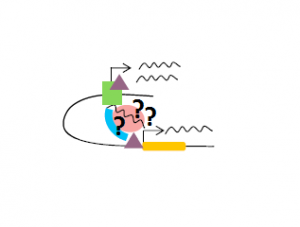Thoughts rethought
Here is the original outline with the initial research question, hypothesis and prediction:
TEMPLATE FOR PROJECT OUTLINE-2015
I am still learning more details about my experimental setup and the protein composition of the chromatin loop of interest to this study, and this continuously expanding knowledge is continuously influencing and shaping the original hypothesis and prediction. I thought it might be interesting to show you the initial ideas to compare later on to those in the final project!
December 4, 2015
My project: The role of eRNA in chromatin looping
 I have finally handed in the final project of this course!
I have finally handed in the final project of this course!
Here is a link – check it out!
The role of eRNA in chromatin looping by Sebastian
Project reflection
This has been the first research proposal-like project I have ever written, and it has been a great experience. The outline has helped me to make some decisions about the project early on. Especially when I was deciding the technique, and what prediction to pursue among several, it helped me early in the process to choose one specific way to do this project, and there are many ways to do so.
I was not an expert on any of the elements in my project before, but as I intended I would be after writing it. Writing about eRNA was not a difficult decision, I simply picked the most interesting topic to me we had been introduced to by that time. Even though many other VERY interesting topics came up afterwards, I was very interested in eRNA all the way through the writing process, and even in the frustration phase, and though I have learned much about eRNA while writing this project, I do not feel like I know enough yet. The entire group of ncRNA is extremely interesting to me, and I will definitely consider writing about ncRNA in future projects and assignments.
The part of the project I enjoyed the most, and was the hardest part, was planning the technique and experiment best to examine the research question. This was fun since I could choose whatever approach and experiment I would like and hard for the same reason because there are quite a few techniques that can be applied. I was happy about choosing the CLIP experiment, since I did not have much knowledge of either CLIP or CHIP before, so the approach of cross-linking and immunoprecipitation was new to me. Since I also had to go into specifics about what type of model (cell line) I would use and important control experiments, I felt like I was working on solving a big puzzle, which I think is a good description of the planning process.
After the entire experiment was planned, I also had to come up with some possible outcomes, and how these would be interpreted. This part of the project I felt very comfortable doing since making direct conclusions and interpreting scientific data and results were something we had went thoroughly through in class.
Planning such a project is a very big task, and requires a lot of consideration and constantly exploring new ideas and problems that occur doing the planning process. A lot needs to be addressed, and I reworded my hypothesis and prediction several times since I became more aware about some of the specificities. I am very satisfied with my project, and I think it is the perfect finale of this course since I had to integrate MANY things, if not all, I had learned in class.
December 5
Annotated Bibliography and Final Project in the making
Here is the link to the Annotated Bibliography of my Final Project:
Annotated Bibliography of the Final Project
I have decided to make a post about how my hypothesis and prediction looked like in the beginning of writing the project, and how it changed during the writing process to become tailored to my study:
The evolution and adaption of my hypothesis and prediction
Initial:
HYPOTHESIS:
eRNA contributes to chromatin loop formation by bridging structural factors and/or effector molecules between the enhancer and the target promoter to facilitate chromosomal loop formation
PREDICTION:
If my hypothesis is right, it would be possible to isolate eRNA with bound structural looping factors known to interact with the enhancer and the promoter sequence in a chromatin loop. It could further be demonstrated that these eRNA-looping factors are necessary for loop formation by blocking/mutating the binding sites of the effector molecules involved in eRNA interaction.
Final:
HYPOTHESIS:
eRNA contributes to chromatin loop formation by linking proteins between enhancer and the target promoter during chromosomal looping.
PREDICTION:
If this hypothesis is right, it will be possible to isolate eRNA with bound proteins known to interact with the β-globin LCR and the promoter of β-globin major gene during chromatin looping.
It is further possible that the transcriptional stage of locus activation, ranging from inactivated to fully transcribed, influences the contribution of eRNA to either loop formation or loop maintenance. This study will examine if eRNA can be isolated with bound proteins during different stages of β-globin locus activation and chromatin structure.
